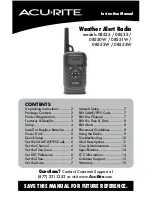
54
10. Mounting the outdoor sensor
Observe the following for selection of the mounting site:
The mounting site must be exposed for wind speed and wind direction to be measured correctly.
A minimum distance to buildings of 10 metres is recommended.
The outdoor sensor should not be installed close to the ground either, but at least at a height of
2 - 3 m above the ground. An optimal mounting location would be, for example, on a flat parking
garage or a carport.
Do not mount the outdoor sensor under or close to trees or bushes because dropping foliage may
clog the opening in the rain sensor.
The range between the transmitter in the outdoor sensor and the weather station is up to 150 m
in a free range (at a direct line of sight between transmitter/receiver).
The range that can actually be achieved, however, is lower since there are walls, furniture, win-
dows or plants between the outdoor sensor and the weather station.
Another interference that strongly reduces range is proximity to electrical/electronic devices,
cables or metal parts. Another problem are reinforced concrete ceilings, metal-vaporised isolat-
ing glass windows or other devices on the same transmission frequency (868 MHz).
Before firmly attaching the outdoor sensor, you should perform a function and reception test.
After inserting the batteries into the outdoor sensor and weather station, the corresponding
measured values should be displayed after several minutes; see chapter 11.
Important!
At the top of the outdoor sensor housing, there is a mark “N” and an arrow for the direction
“North” between the sensor and wind speed sensor.
Attach the outdoor sensor so that the arrow points due North. The correct directions can be de-
termined with a compass (e.g. integrated in some smartphones as an app or can be downloaded).
If you do not have a compass, you may also use a map or map material from the internet to per-
form at least approximate alignment.
If this is not observed, the direction display in the weather station will not be accurate.
Proceed as follows for mounting (observe the figures on the next page):
We recommend that you insert the batteries into the outdoor sensor before mounting (see chap-
ter 11) and to perform a function test.
The outdoor sensor can be installed via the holder (29) either on a horizontal or a vertical surface. Use
suitable screws and, if applicable, dowels for this.
Alternatively, the outdoor sensor can be mounted to a suitable tube using the holder (29) and the assembly
bracket (30). This can be done using, e.g., tube holders for satellite aerials as well.
For horizontal alignment of the outdoor sensor, there is a small spirit level (23) at the top. Install
the outdoor sensor so that the small air bubble in the spirit level is at the centre of the circular
mark.
















































